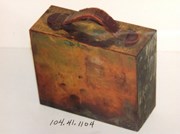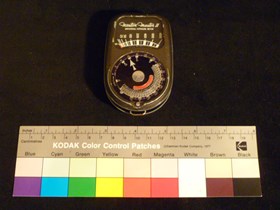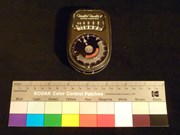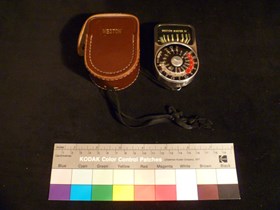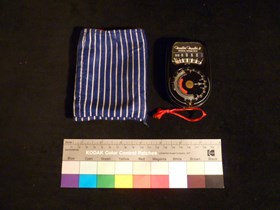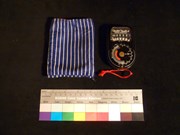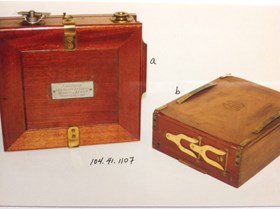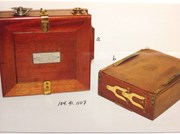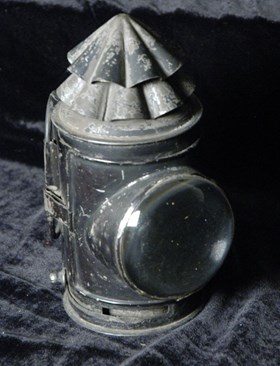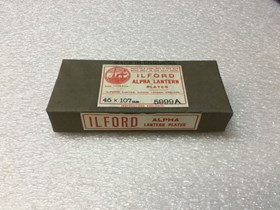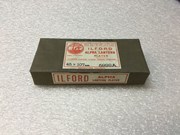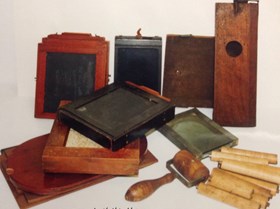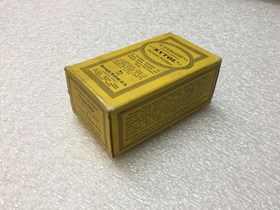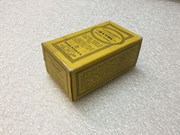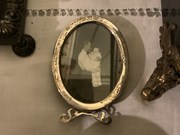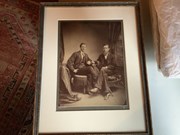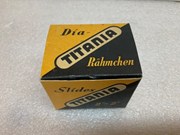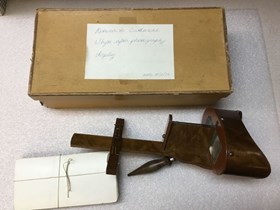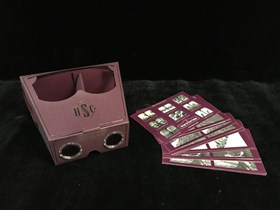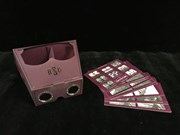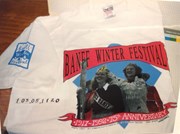Narrow Results By
- Date
- 1885 – 1890
- Material
- wood; metal; skin
- Catalogue Number
- 104.41.1010 a,b
- Description
- “Premo D” folding camera (4”x5” format) with a leather covered wooden frame. The camera has a leather handle centred on the top and held in place with brass keepers. The hinged front of the camera opens to lie flat and has a brass track (3.2 cm wide) running down the centre. The red leather bell…
1 image
- Title
- Camera
- Date
- 1885 – 1890
- Material
- wood; metal; skin
- Dimensions
- 12.0 x 14.5 x 17.5 cm
- Description
- “Premo D” folding camera (4”x5” format) with a leather covered wooden frame. The camera has a leather handle centred on the top and held in place with brass keepers. The hinged front of the camera opens to lie flat and has a brass track (3.2 cm wide) running down the centre. The red leather bellows extend along the track and end with a wooden frame that holds a lens (missing) and a viewfinder. The camera also has hinged doors on the right side and on the back.b) Film plate holder loaded in the camera’s side chamber.
- Subject
- households
- photography
- hobbies
- Credit
- Gift of Unknown, 1968
- Catalogue Number
- 104.41.1010 a,b
Images
This material is presented as originally created; it may contain outdated cultural descriptions and
potentially offensive content.
Read more.
- Date
- 1883 – 1926
- Material
- cardboard; metal; glass;
- Catalogue Number
- 104.41.0129 a,b
- Description
- Two camera lenses housed in a repurposed Hammond box with “OLD ‘ADON’ Telephoto in shutter circa 1990’s” written in black ink on the front.The larger lens with shutter was manufactured by Bausch & Lomb Optical Co., originally a company that produced prescription eye-wear in the mid to late-1800s be…
1 image
- Title
- Camera Lenses
- Date
- 1883 – 1926
- Material
- cardboard; metal; glass;
- Dimensions
- 5.7 x 7.8 x 14.5 cm
- Description
- Two camera lenses housed in a repurposed Hammond box with “OLD ‘ADON’ Telephoto in shutter circa 1990’s” written in black ink on the front.The larger lens with shutter was manufactured by Bausch & Lomb Optical Co., originally a company that produced prescription eye-wear in the mid to late-1800s before expanding into camera lenses and microscopes/telescopes towards the turn of the century. The company was founded in Rochester NY.The smaller lens was manufactured by Gundlach-Manhattan Optical Co., a merged company between Gundlach Optical Co. and Manhattan Optical Co. that took place in 1902, which produced various kinds of bellows cameras. Both companies were based in Rochester NY prior to merging.
- Credit
- Gift of Nicholas Morant, Banff, 2006
- Catalogue Number
- 104.41.0129 a,b
Images
This material is presented as originally created; it may contain outdated cultural descriptions and
potentially offensive content.
Read more.
- Date
- 1995
- Material
- leather; metal; wood; plastic
- Catalogue Number
- 104.41.0081 a-d
- Description
- Case: Manufacturer label on inside of lid reads G.R. TAYLOR LTD. TRUNKS & SAMPLE CASES WINNIPEG. No manufacturer details available online. Case is triangular in shape with a central carrying handle and metal clasps located along the narrow upper edge - one side of the case folds down. Padded suppor…
1 image
- Title
- Camera Tripod
- Date
- 1995
- Material
- leather; metal; wood; plastic
- Dimensions
- 28.3 x 28.6 x 138.5 cm
- Description
- Case: Manufacturer label on inside of lid reads G.R. TAYLOR LTD. TRUNKS & SAMPLE CASES WINNIPEG. No manufacturer details available online. Case is triangular in shape with a central carrying handle and metal clasps located along the narrow upper edge - one side of the case folds down. Padded supports and buckled leather straps located inside to keep the tripod in place - straps not done up at time of processing. NICHOLAS MORANT written in white along the narrow top edge on either side of carrying handle, TR1 written in yellow paint in the top left end of narrow edge and in top right corner of opening side, the torn remains on a Canadian Pacific Railway label remains on the side that does not open. Tripod: Manufacturer mark on metal support below the camera support base reads [D]INEMA EQUIPMENT CO. No manufacturer details available online. Tripod dimensions are 124.1x14.7x14.7 cm. The legs of the tripod are wood, with metal spikes at the bottoms, metal brackets, and a metal camera support rig [possibly cast iron]. The legs are held together with a buckled strip of leather at the bottom. Also in the case is a metal pole with a black plastic handle that can screw into the camera support base for use as a controller and a plastic zip-lock baggie containing a length of chain with 4 metal clasps throughout 286.0 cm in length.
- Credit
- Gift of Nicholas Morant, Banff, 2006
- Catalogue Number
- 104.41.0081 a-d
Images
This material is presented as originally created; it may contain outdated cultural descriptions and
potentially offensive content.
Read more.
Cut-Film Holder
https://archives.whyte.org/en/permalink/artifact104.41.1104
- Date
- 1885 – 1900
- Material
- metal; skin
- Catalogue Number
- 104.41.1104
- Description
- Metal box with opening compartments and leather carrying handle marked “45”. “Pat. May 31. 87. Aug. 3. 90” stamped on top. Spring loaded film changing apparatus inside.
1 image
- Title
- Cut-Film Holder
- Date
- 1885 – 1900
- Material
- metal; skin
- Dimensions
- 4.5 x 11.5 cm
- Description
- Metal box with opening compartments and leather carrying handle marked “45”. “Pat. May 31. 87. Aug. 3. 90” stamped on top. Spring loaded film changing apparatus inside.
- Subject
- photography
- Vaux family
- Credit
- Gift of Molly Vaux, New York, USA, 1999
- Catalogue Number
- 104.41.1104
Images
This material is presented as originally created; it may contain outdated cultural descriptions and
potentially offensive content.
Read more.
Exposure Meter
https://archives.whyte.org/en/permalink/artifact104.41.1118
- Date
- 1888
- Material
- metal; paint; plastic
- Catalogue Number
- 104.41.1118
- Description
- Hand held exposure/light meter made by Weston Electrical Instrument Company in a grey metal finish. Along both sides of the meter are a series of protruding lines that allow one to safely grip the object. At the bottom of the artifact there is a metal hook, which would have allowed a string to be a…
1 image
- Title
- Exposure Meter
- Date
- 1888
- Material
- metal; paint; plastic
- Dimensions
- 2.0 x 6.0 x 9.5 cm
- Description
- Hand held exposure/light meter made by Weston Electrical Instrument Company in a grey metal finish. Along both sides of the meter are a series of protruding lines that allow one to safely grip the object. At the bottom of the artifact there is a metal hook, which would have allowed a string to be attached like on the other Weston meter’s owned by Nicholas. There is also no longer a case to protect this particular object. In the top of the exposure meter there is a clear plastic covering. Along the very top there us the name of the manufacturer in white cursive lettering that reads “Weston Master II” and written underneath in capital letters “UNIVERSAL EXPOSURE METER.” Below this is the light scale where the value of the scene would be indicated. The scale contains the values “0” “25” “50” “100” “200” “400” “800” “1600,” which means that the two values on this instrument are calibrated 0-50 and 0-1600. (candles per square foot.)Below there is a circular face with several figures and a dial that turns/rotates. The outside row of figures on the exposure control dial represents the light value settings and corresponds to the light values on the light scale. Below the round dial there is a tiny circular button that is used to set the exposure control dial for film speed. As the dial turns it reveals the “EMULSION SPEED” with a red baize finish that has become worn throughout its life. The row of figures at the bottom of the top dial is the f/stop values and has an “f” to make this more apparent for the user. The row of figures directly below the f/stop settings are the shutter speeds. After setting the exposure control dial to the light value obtained on the light scale, any of the combinations of f/stop and shutter speed directly opposite each other are correct. On the rear of the meter there is a black plastic covering that contains several circular cut outs that are called a hir.ged baffle. This can be swung open (against the case) using the gold latch, which clips into a tiny hole or socket when the user wishes it to be closed. When opened the light sensitive photo cell is directly beneath this baffle and contains several protruding circles. When the baffle is open, the scale range is 0-50; when the baffle is closed, the scale range is 0-1600. Below there is an oval shaped face with extensive information that is held in place with two small screws on both the viewer left and right side. There is silver lettering on a black background that reads “WESTON ELEC. INST. CORP.” “NEWARK, N.J., U.S.A.” A silver backing separates the patent information and has black writing that reads “MODEL 735” on the viewer left side. On the viewer right side the number “7454510” is engraved. In the middle there is a gold-coloured screw with the words “ZERO CORRECTOR” written in black. Below this there is the patent information; “U.S. PATENTS” “2,274,441” “2,073,790” “2,346,555” “2,137,466” “2,463,770.” Below these numbers are the “FOREIGN PATENTS” “FRENCH 862,770” “BRITISH 531,996” “CAN. 347,085” “CAN. 411,975” At the very bottom underneath there is the manufacturer’s location; “MADE IN U.S.A.”
- Subject
- photography
- Nick Morant
- Credit
- Gift of Nicholas Morant, Banff, 2006
- Catalogue Number
- 104.41.1118
Images
This material is presented as originally created; it may contain outdated cultural descriptions and
potentially offensive content.
Read more.
- Date
- 1888
- Material
- leather; metal; nylon; plastic; thread; paint
- Catalogue Number
- 104.41.1119 a-b
- Description
- Hand held light meter in a pear shape with a stainless steel body and leather case. Along both sides of the meter are a series of protruding lines that allow one to safely grip the object. On the viewer right there is a pointer lock, which is locked when positioned upwards and released when positio…
1 image
- Title
- Exposure Meter
- Date
- 1888
- Material
- leather; metal; nylon; plastic; thread; paint
- Dimensions
- 2.0 x 5.0 x 9.0 cm
- Description
- Hand held light meter in a pear shape with a stainless steel body and leather case. Along both sides of the meter are a series of protruding lines that allow one to safely grip the object. On the viewer right there is a pointer lock, which is locked when positioned upwards and released when positioned downward. At the bottom of the artifact there is a metal hook, which has a black string running through. In the top of the light meter there is clear plastic covering. Written in capital letters is “WESTON MATER IV” above the light scale. The lights scale contains the numbers “0” “25” “50” “100” “200” “400” “800” “1600,” which means that the 2 values calibrated on this instrument are 0-50 and 0-1600.Below there is another light scale in the form of a circular face with several figures and a dial that turns/rotates. The dial on the outside has a series of protruding lines to make movement easier and contains a row of figures. This dial controls the lens aperture (f/stop) scale and has a series of values representing the focal length of the lens; “1” “1.4” “2” “2.8” “4” “5.6”. On the same dial there is also the letters “EVS,” which stands for the exposure value setting with a cut out window that reveals the EVS values. Working in a clockwise direction (on the same dial) there is also the letters “U,” “A with “1/2” over top,” an enclosed arrow that is known as the normal arrow, a “C” with “2x” on top of it, and a “0”. As this dial is turned it reveals a partly red baize and black numbers on a silver background that represents the shutter speeds in fractions of seconds. The inside dial has a series of light scale values and an exposure index window that line up with the “U,” “A,” normal arrow, “C,” and “0.” On the opposite side of the exposure index window is the exposure index knob. On the rear of the meter there is a black plastic covering that contains several circular cut outs that are called a hir.ged baffle. This can be swung open (against the case) using the gold latch, which clips into a tiny hole or socket when the user wishes it to be closed. When opened the light sensitive photo cell is directly beneath this baffle and contains several protruding circles. When the baffle is open, the scale range is 0-50; when the baffle is closed, the scale range is 0-1600. Below there is an oval shaped face with extensive information that is held in place with two small screws on both the viewer left and right side. There is black lettering on a silver background that reads “UNIVERSAL EXPOSURE METER” “MODEL 745” SER.W” and “107522” engraved. Below the manufacturer information is listed; “DAYSTROM. INCORPORATED” “WESTON INSTRUMENTS DIVISION”. “NEWARK. N.J.. U.S.A.” In the middle there is a gold-coloured screw with the words “ZERO CORRECTOR” written in black. On the viewer left side of the zero corrector there is patent information; “U.S. PATENTS” “2463770” and on the viewer right side “FOREIGN PATS” “CAN. 411975”. At the very bottom on either side of a circular cut out are “ASA” and “K=1.0” written. Underneath “MADE IN JAPAN” has also been written.There is also a brown leather case with this object. The front has “WESTON” written in gold letters. On the viewer left there is a brown button that allows the case to be opened or fastened shut. The leather has been stitched together with light brown thread that is visible. The bottom of the case has an opening for the black string to be strung through so that the light meter and case are attached. On the rear there is a brown leather strap stitched.
- Subject
- photography
- Nick Morant
- Credit
- Gift of Nicholas Morant, Banff, 2006
- Catalogue Number
- 104.41.1119 a-b
Images
This material is presented as originally created; it may contain outdated cultural descriptions and
potentially offensive content.
Read more.
- Date
- 1888
- Catalogue Number
- 104.41.1120 a-b
- Description
- Hand held light meter in a pear shape with a stainless steel body and leather case. Along both sides of the meter are a series of protruding lines that allow one to safely grip the object. At the bottom of the artifact there is a metal hook, which has a red string running through.There is a clear p…
1 image
- Title
- Exposure Meter
- Date
- 1888
- Description
- Hand held light meter in a pear shape with a stainless steel body and leather case. Along both sides of the meter are a series of protruding lines that allow one to safely grip the object. At the bottom of the artifact there is a metal hook, which has a red string running through.There is a clear plastic covering located at the top of the meter. Written in cursive letters is the company name “WESTON MATER II”. Underneath this written in capital letters is “UNIVERSAL EXPSOURE METER”. The light scale underneath contains the numbers “0” “25” “50” “100” “200” “400” “800” “1600,” which means that the 2 values calibrated on this instrument are 0-50 and 0-1600. Underneath the scale the word “Light” is present. Below there is another light scale in the form of a circular face with several figures and a dial that turns/rotates. The outside row of figures on the exposure control dial represents the light value settings and corresponds to the light values on the light scale at the top. The row of figures at the bottom of the top dial is the f/stop values and has an “f” to make this more apparent for the user.. On the same dial there is silver letters that have a line that correspond to the figures on the outside dial; “U,” “A with “1/2” underneath,” an arrow that is known as the normal arrow, a “C” with “2x” below it, and a “0”. As this dial is turned it reveals a partly red baize and the emulsion speed, which is self-evident as the words “EMULSION SPEED” are present. The row of figures directly below the f/stop settings are the shutter speeds. The outside row of figures is the light values, which is apparent as the word “LIGHT” with an arrow points to these values. After setting the exposure control dial to the light value obtained on the light scale, any of the combinations of f/stop and shutter speed directly opposite each other are correct. Below the round dial there is a tiny circular button that is used to set the exposure control dial for film speed.On the rear of the meter there is a black plastic covering that contains several circular cut outs that are called a hir.ged baffle. This can be swung open (against the case) using the gold latch, which clips into a tiny hole or socket when the user wishes it to be closed. When opened the light sensitive photo cell is directly beneath this baffle and contains several protruding circles. When the baffle is open, the scale range is 0-50; when the baffle is closed, the scale range is 0-1600. Below there is an oval shaped face with extensive information that is held in place with two small screws on both the viewer left and right side. There is silver lettering on a black background that reads “WESTON ELEC. INST. CORP.” “NEWARK, N.J., U.S.A.” A silver backing separates the patent information and has black writing that reads “MODEL 735” on the viewer left side; “No” is present in the middle; “8284703” is engraved on the viewer right side. In the middle there is a brass screw with the words “ZERO CORRECTOR” written in black around its circumference. On the viewer left side of the zero corrector is the patent information; “U.S. PATENTS” “1,779,574” “1,982,406” “2,073,790” and on the viewer right side continued patent information “U.S. PATENTS” “2,137,466” “2,274,441” “2,346,555”. Below these numbers are the “FOREIGN PATENTS” “FRENCH 862,770” “BRITISH 531,996” “CAN. 347,085” “CAN. 411,975” At the very bottom underneath there is the manufacturer’s location; “MADE IN U.S.A.” written in black on a silver background.There is also a blue case with white stripes and a red inner lining that would be used to protect the case. This would not have been originally sold with the exposure meter and was most likely hand made in an effort to protect the meter. Blue stitches hold the fabric together and are visible.
- Subject
- photography
- Nick Morant
- Credit
- Gift of Nicholas Morant, Banff, 2006
- Catalogue Number
- 104.41.1120 a-b
Images
This material is presented as originally created; it may contain outdated cultural descriptions and
potentially offensive content.
Read more.
- Date
- 1885 – 1900
- Material
- wood; metal
- Catalogue Number
- 104.41.1107 a,b
- Description
- (a) Wooden film roller with brass fittings. Metal plate on top reads: “EASTMAN DRY PLATE & FILM CO. Rochester, N.Y., U.S.A. PATENTED MAY 5, 1885.” (b) Wooden film roller with brass fittings, top stamped: “EASTMAN KODAK CO. PAT. MAY 5, 1885. OTHER PATENTS APPL’D FOR IN ALL COUNTRIES.”
1 image
- Title
- Film Roller
- Date
- 1885 – 1900
- Material
- wood; metal
- Dimensions
- 6.0 x 18.0 cm
- Description
- (a) Wooden film roller with brass fittings. Metal plate on top reads: “EASTMAN DRY PLATE & FILM CO. Rochester, N.Y., U.S.A. PATENTED MAY 5, 1885.” (b) Wooden film roller with brass fittings, top stamped: “EASTMAN KODAK CO. PAT. MAY 5, 1885. OTHER PATENTS APPL’D FOR IN ALL COUNTRIES.”
- Subject
- photography
- Vaux family
- Credit
- Gift of Molly Vaux, New York, USA, 1999
- Catalogue Number
- 104.41.1107 a,b
Images
This material is presented as originally created; it may contain outdated cultural descriptions and
potentially offensive content.
Read more.
Kerosene Lantern
https://archives.whyte.org/en/permalink/artifact102.05.1018
- Date
- 1880 – 1885
- Material
- metal; glass
- Catalogue Number
- 102.05.1018
- Description
- Black metal lantern with large glass lens in opening door. Inside is a removable fuel reservoir with knob to adjust wick. Sliding screen controls amount of light. “Private Property. VAUX 84” scratched into base of lantern.
1 image
- Title
- Kerosene Lantern
- Date
- 1880 – 1885
- Material
- metal; glass
- Dimensions
- 17.0 x 9.0 cm
- Description
- Black metal lantern with large glass lens in opening door. Inside is a removable fuel reservoir with knob to adjust wick. Sliding screen controls amount of light. “Private Property. VAUX 84” scratched into base of lantern.
- Subject
- photography
- Vaux family
- camping
- hiking
- Credit
- Gift of Molly Vaux, New York, USA, 1999
- Catalogue Number
- 102.05.1018
Images
This material is presented as originally created; it may contain outdated cultural descriptions and
potentially offensive content.
Read more.
Lantern Plates
https://archives.whyte.org/en/permalink/artifact104.41.0206
- Date
- 1889 – 1910
- Material
- paper; glass;
- Catalogue Number
- 104.41.0206
- Description
- One paper-wrapped package of 45x107mm Ilford Alpha Lantern Plates with white and red paper adhesive labels on the top and front of the package containing manufacturer details. These lantern plates would serve as the positive mount for the lantern slide made from the original negative. Lantern slide…
1 image
- Title
- Lantern Plates
- Date
- 1889 – 1910
- Material
- paper; glass;
- Dimensions
- 2.0 x 11.6 x 5.3 cm
- Description
- One paper-wrapped package of 45x107mm Ilford Alpha Lantern Plates with white and red paper adhesive labels on the top and front of the package containing manufacturer details. These lantern plates would serve as the positive mount for the lantern slide made from the original negative. Lantern slides are glass-based transparencies that were displayed by being projected through an early projector called a magic lantern. Starting as hand-painted images on glass, lantern slides quickly adapted to first black-and-white and then colour photography and faded from popularity with the rise of celluloid film and motion pictures.
- Credit
- Gift of Robert Crosby Family, Banff, 1998
- Catalogue Number
- 104.41.0206
Images
This material is presented as originally created; it may contain outdated cultural descriptions and
potentially offensive content.
Read more.
Philadelphia Rod
https://archives.whyte.org/en/permalink/artifact104.44.1017
- Date
- 1880 – 1910
- Material
- wood; metal
- Catalogue Number
- 104.44.1017
- Description
- (a) Philadelphia rod. Brass tip base, varnished wood, split slide ruler, with vernier scale impressed and painted. Unit has adjustable round metal target. Developed in late 18th century Philadelphia for long range and hillside surveys. Ultimate height of extended rod is one third higher than a stad…
1 image
- Title
- Philadelphia Rod
- Date
- 1880 – 1910
- Material
- wood; metal
- Dimensions
- 4.5 x 168.0 cm
- Description
- (a) Philadelphia rod. Brass tip base, varnished wood, split slide ruler, with vernier scale impressed and painted. Unit has adjustable round metal target. Developed in late 18th century Philadelphia for long range and hillside surveys. Ultimate height of extended rod is one third higher than a stadia rod. (b) Wooden pole with black tape, “VAUX” written in pencil on side, function unknown.
- Subject
- photography
- Vaux family
- surveying
- Credit
- Gift of Hugh J. McCauley, Bryn Mawr, USA, 1999
- Catalogue Number
- 104.44.1017
Images
This material is presented as originally created; it may contain outdated cultural descriptions and
potentially offensive content.
Read more.
Photograph Accessory
https://archives.whyte.org/en/permalink/artifact104.41.1100
- Date
- 1880 – 1920
- Material
- wood; metal; skin; glass
- Catalogue Number
- 104.41.1100
- Description
- Miscellaneous photographic accessories including plate holders, film rollers, hand roller, tripod top and wooden camera parts. Some pieces have “George Vaux Jr.” written on them. One plate holder has “10/19 1890” written on it and a patent date of March 8, 1881. Some of the film rollers have a pate…
1 image
- Title
- Photograph Accessory
- Date
- 1880 – 1920
- Material
- wood; metal; skin; glass
- Description
- Miscellaneous photographic accessories including plate holders, film rollers, hand roller, tripod top and wooden camera parts. Some pieces have “George Vaux Jr.” written on them. One plate holder has “10/19 1890” written on it and a patent date of March 8, 1881. Some of the film rollers have a patent date of May 5, 1885.
- Subject
- photography
- Vaux family
- Credit
- Gift of Molly Vaux, New York, USA, 1999
- Catalogue Number
- 104.41.1100
Images
This material is presented as originally created; it may contain outdated cultural descriptions and
potentially offensive content.
Read more.
Photograph Developer
https://archives.whyte.org/en/permalink/artifact104.41.0203
- Date
- 1880 – 1940
- Material
- cardboard;
- Catalogue Number
- 104.41.0203
- Description
- Empty cardboard box of Burroughs Wellcome & Co. ‘Tabloid’ (Photographic) ‘Rytol’ Universal Developer that could be used on plates, film, bromide and gaslight papers, and glass lantern slides. Directions on how to use the developer are printed in black throughout the yellow box. Developers were eith…
1 image
- Title
- Photograph Developer
- Date
- 1880 – 1940
- Material
- cardboard;
- Dimensions
- 9.0 x 4.0 x 5.1 cm
- Description
- Empty cardboard box of Burroughs Wellcome & Co. ‘Tabloid’ (Photographic) ‘Rytol’ Universal Developer that could be used on plates, film, bromide and gaslight papers, and glass lantern slides. Directions on how to use the developer are printed in black throughout the yellow box. Developers were either chemical powders or liquids that would be added to another agent [usually a bath] to create a solution that would then be used to expose the positive photograph after it had been transferred from the original negative. Different concentrations or chemicals used could yield different results, usually in regards to contrast and colour of the finished image, depending on the photographic base.
- Credit
- Gift of Robert Crosby Family, Banff, 1998
- Catalogue Number
- 104.41.0203
Images
This material is presented as originally created; it may contain outdated cultural descriptions and
potentially offensive content.
Read more.
Photographic Print
https://archives.whyte.org/en/permalink/artifact105.02.0001
- Date
- 1880 – 1910
- Material
- paper
- Catalogue Number
- 105.02.0001
- Description
- A black and white oval shaped photograph of a man, in shirtsleeves, holding a baby [Edmee Moore] in the doorway of a log cabin.
1 image
- Title
- Photographic Print
- Date
- 1880 – 1910
- Material
- paper
- Dimensions
- 5.5 (image) x 7.5 (image) cm
- Description
- A black and white oval shaped photograph of a man, in shirtsleeves, holding a baby [Edmee Moore] in the doorway of a log cabin.
- Subject
- households
- family
- children
- photography
- Credit
- Gift of Pearl Evelyn Moore, Banff, 1979
- Catalogue Number
- 105.02.0001
Images
This material is presented as originally created; it may contain outdated cultural descriptions and
potentially offensive content.
Read more.
Photographic Print
https://archives.whyte.org/en/permalink/artifact105.02.0022
- Date
- 1880 – 1890
- Material
- paper, mat board
- Catalogue Number
- 105.02.0022
- Description
- A black and white studio photograph of John Brewster and a brother (George ?) sitting together in chairs with legs crossed. The photograph is framed with a wide grey mat and a dark ornate frame.
1 image
- Title
- Photographic Print
- Date
- 1880 – 1890
- Material
- paper, mat board
- Dimensions
- 21.2 x 15.6 cm
- Description
- A black and white studio photograph of John Brewster and a brother (George ?) sitting together in chairs with legs crossed. The photograph is framed with a wide grey mat and a dark ornate frame.
- Subject
- photography
- families
- households
- John Brewster
- Credit
- Gift of Pearl Evelyn Moore, Banff, 1979
- Catalogue Number
- 105.02.0022
Images
This material is presented as originally created; it may contain outdated cultural descriptions and
potentially offensive content.
Read more.
- Date
- 1991
- Material
- plastic; cardboard
- Catalogue Number
- 105.05.0016
- Description
- Unused box of slide binders. Box is yellow, black, and beige with German and English writing. Inside are 20 square plastic slides with white fronts and black backing. Small piece of paper with instructions in German, English, and French.
1 image
- Title
- Slide Binder
- Date
- 1991
- Material
- plastic; cardboard
- Dimensions
- 5.5 x 6.5 x 5.5 cm
- Description
- Unused box of slide binders. Box is yellow, black, and beige with German and English writing. Inside are 20 square plastic slides with white fronts and black backing. Small piece of paper with instructions in German, English, and French.
- Subject
- Whyte home
- photography
- slides
- Credit
- Gift of Catharine Robb Whyte, O. C., Banff, 1979
- Catalogue Number
- 105.05.0016
Images
This material is presented as originally created; it may contain outdated cultural descriptions and
potentially offensive content.
Read more.
- Date
- 1880 – 1910
- Material
- wood; metal
- Catalogue Number
- 104.44.1016
- Description
- Wooden stadia rod. Brass tip base, varnished single wood shaft with impressed and painted vernier scale numbers and fractions. Used to measure vertical short distances and horizontal lengths. Stadia, from Latin “Stadium,” based on a unit of length for Roman racing arenas.
1 image
- Title
- Stadia Rod
- Date
- 1880 – 1910
- Material
- wood; metal
- Dimensions
- 5.0 x 199.0 cm
- Description
- Wooden stadia rod. Brass tip base, varnished single wood shaft with impressed and painted vernier scale numbers and fractions. Used to measure vertical short distances and horizontal lengths. Stadia, from Latin “Stadium,” based on a unit of length for Roman racing arenas.
- Subject
- photography
- Vaux family
- surveying
- Credit
- Gift of Hugh J. McCauley, Bryn Mawr, USA, 1999
- Catalogue Number
- 104.44.1016
Images
This material is presented as originally created; it may contain outdated cultural descriptions and
potentially offensive content.
Read more.
- Date
- 1883 – 1979
- Material
- cardboard; wood; metal;
- Catalogue Number
- 105.05.0040 a,b
- Description
- Wooden hand-held stereoscope with a long base along which the card frame can slide, goggle-shaped lens housing that blocks out light around the sides, two square lenses angled slightly towards the center, a central blocker, and a pointed fold-down handle. The card frame is a separate piece that sli…
1 image
- Title
- Stereoscope
- Date
- 1883 – 1979
- Material
- cardboard; wood; metal;
- Dimensions
- 10.1 x 33.5 x 16.0 cm
- Description
- Wooden hand-held stereoscope with a long base along which the card frame can slide, goggle-shaped lens housing that blocks out light around the sides, two square lenses angled slightly towards the center, a central blocker, and a pointed fold-down handle. The card frame is a separate piece that slides on and off the end of the long base and features two wire holders that fold out to fit the card. Also includes a stack of manufactured stereoscope cards that mostly feature scenes from Palestine and the United States that have spots of colour tinting, possibly hand-applied. Everything is housed in a cardboard shoe box with a white “COES & STODDER” sticker on one short side. Written on one short side of the lid is “STEREOPTICAN” in black ink and taped to the lid is a piece of paper that reads “Return to Catharine Whyte after photograph display” signed and dated by Maryalice Stewart 14 February 1979.
- Subject
- souvenir
- commemorative
- photography
- Credit
- Gift of Catharine Robb Whyte, O. C., Banff, 1979
- Catalogue Number
- 105.05.0040 a,b
Images
This material is presented as originally created; it may contain outdated cultural descriptions and
potentially offensive content.
Read more.
- Date
- 1998 – 1999
- Material
- paper; plastic
- Catalogue Number
- 105.05.1046 a,b
- Description
- (a) One bergundy coloured cardboard stereoviewer with plastic lenses, “The Heritage Stereoview Company” embossed at back. (b) Series of 18 stereo cards.
1 image
- Title
- Stereoviewer
- Date
- 1998 – 1999
- Material
- paper; plastic
- Dimensions
- 10.0 x 18.0 cm
- Description
- (a) One bergundy coloured cardboard stereoviewer with plastic lenses, “The Heritage Stereoview Company” embossed at back. (b) Series of 18 stereo cards.
- Subject
- photography
- Credit
- Gift of Robert Smith, Banff, 2002
- Catalogue Number
- 105.05.1046 a,b
Images
This material is presented as originally created; it may contain outdated cultural descriptions and
potentially offensive content.
Read more.
- Date
- 1992
- Material
- fibre
- Catalogue Number
- 103.05.1120
- Description
- White t-shirt with a coloured copy of Bill Gibbons photograph of Banff Winter Festival crowning of the Queen. The right sleeve bears the “Banff Winter Festival” logo in blue and white. The photograph is boardered with banners reading “Banff Winter Festival” and “1917 - 1992 75th Anniversary.”
1 image
- Title
- T-Shirt
- Date
- 1992
- Material
- fibre
- Description
- White t-shirt with a coloured copy of Bill Gibbons photograph of Banff Winter Festival crowning of the Queen. The right sleeve bears the “Banff Winter Festival” logo in blue and white. The photograph is boardered with banners reading “Banff Winter Festival” and “1917 - 1992 75th Anniversary.”
- Credit
- Gift of Alex Emond, Banff, 1992
- Catalogue Number
- 103.05.1120
Images
This material is presented as originally created; it may contain outdated cultural descriptions and
potentially offensive content.
Read more.








